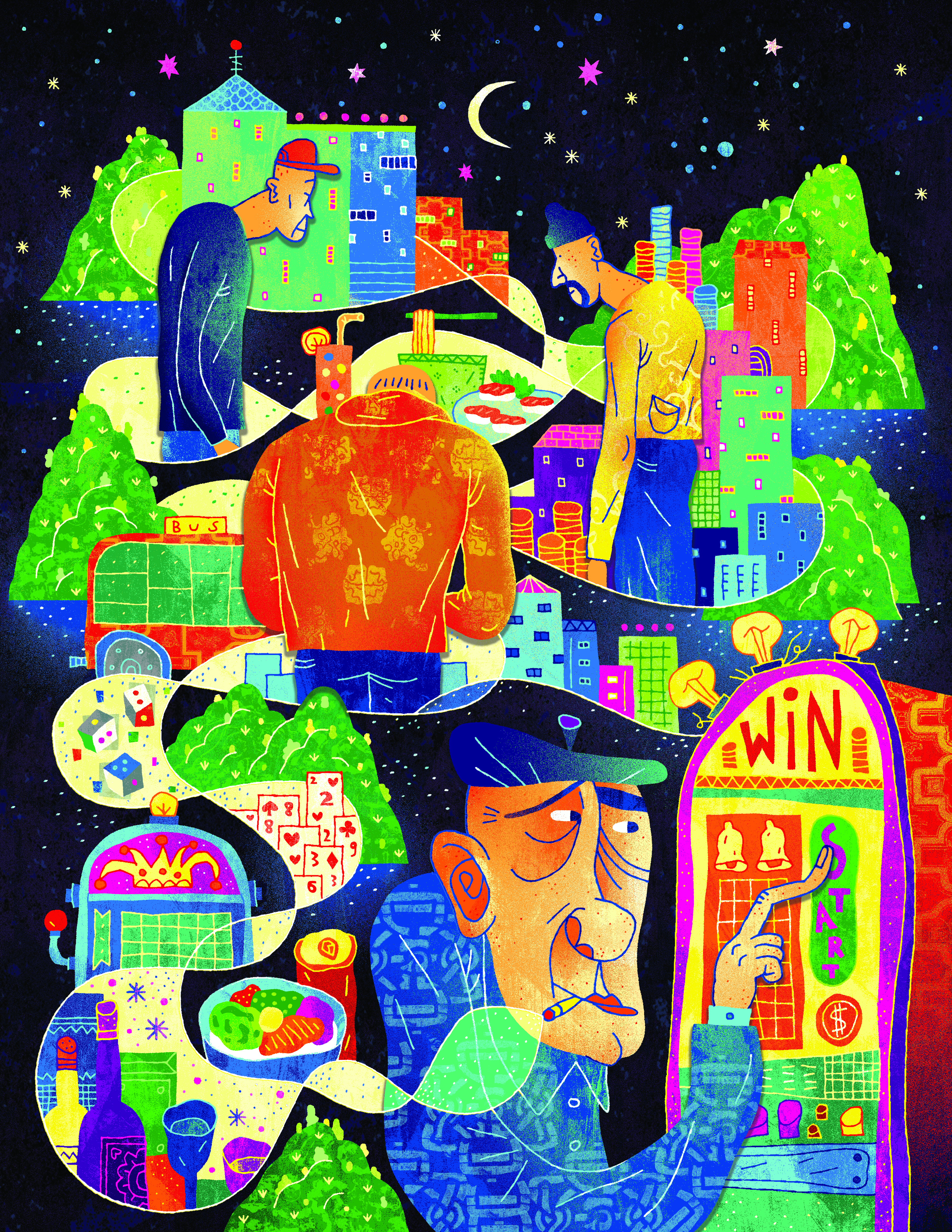Walking into a casino in the United States, you might feel like you have entered Macau rather than Las Vegas. Around the floor are games like Baccarat, Sic Bo, and Pai Gow poker. Hong Kong pop stars are performing concerts. Dim sum is served at restaurants with names such as “Red 8” or “Mystique.” And, accordingly, a sizable proportion of patrons are Asian. These are not high-rollers from abroad but rather immigrants largely living on poverty wages. They are often attracted by advertisements in Chinese newspapers and posters in majority-Asian neighborhoods––communities where casinos strategically send free shuttle buses to pick up customers who do not own cars and hand out free vouchers with the ride.
These are intentional marketing choices by casinos to court Asian immigrant customers––a demographic already at high risk for developing a gambling addiction. Selective advertising, easy access, and other social factors constitute a slew of risk factors for Asian Americans. While there are no comprehensive statistics on gambling addiction by ethnicity, studies show Asian immigrants experience gambling disorders at rates ranging from 6 to 60 percent, depending on their nationality. Comparatively, the national average is 1 to 2 percent. The evidence shows that Asian American gambling addiction is an intergenerational public health crisis driven by the casinos that profit from it. Regulating the gambling industry’s marketing practices and investing in immigrant communities is necessary to ameliorate the issue.
While many East and Southeast Asian cultures have long traditions of wagering on games, addiction issues cannot be fully attributed to culture. Studies show that rates of participation in gambling and rates of addiction are higher among Asian immigrants in Western countries than their counterparts in Asia and that “moving to an environment with more gambling opportunities seems to increase disordered gambling in the Asian population.” Moreover, some researchers argue that pointing to cultural stereotypes to explain addiction is racist and downplays the root causes of the problem.
So, why is gambling addiction so prevalent among Asian immigrants? Some advocates say that addicts gamble to pursue dreams of escaping poverty. Others add that the casino can act as a social refuge in an unfamiliar world. Interviewees in Boston, for example, shared that their neighborhoods lack many familiar or linguistically accessible entertainment options. When Asian workers want to decompress after long shifts, casinos offer both––as well as a sense of community. Understanding this helps explain why online gambling is less popular among Asian Americans than casino gambling. The desire for belonging can only be satisfied by an in-person venue, which casinos are more than happy to provide.
Another consideration is casinos’ targeted marketing tactics, which they have hardly tried to hide. Ernie Wu, the director of Asian marketing at Foxwoods Casino, explained that he views marketing to Asians as a positive way of satisfying culturally specific cravings: “Our Asian blood loves to feel the luck,” Wu said. “We call it entertainment; we don’t say it’s ‘gambling.’” Anthony Patrone, Senior Vice President of Marketing at Connecticut’s Mohegan Sun Casino, shared that 25 percent of the Connecticut casino’s table game revenue came from Asian Americans—a customer base that had grown 45 percent in the two years prior to Patrone’s 2007 interview with the Connecticut Courant. At the time, 48 buses brought customers from majority-Asian neighborhoods to Mohegan Sun every day. As Patrone put it, “It is easy to spend capital on a fast-growing market.”
However, this spending has difficult consequences for gamblers and their families. One study found that young Chinese Americans were twice as likely as white students to report concern about their parents’ gambling. In interviews, Asian immigrants described experiencing marital and family strife, domestic violence, poverty, debt, homelessness, and depression as a result of gambling addiction. Unfortunately, Asian Americans are also nationally the ethnic group least likely to use mental health services.
Immigrants who suffer from gambling addiction may also pass it on to their children. Studies show that young, educated Asian Americans suffer disproportionately from gambling disorders. Although Asian American college students are equally or less likely than white students to participate in gambling, among those who do, Asian students are more likely to become addicted to gambling.
To address this public health crisis, we can look at history. Today’s casinos are drawing from another harmful industry’s playbook—that of Big Tobacco. Companies like Phillip Morris also used targeted advertising, easy access, and free samples to sell an addictive product to a vulnerable market: children. In 1998, the largest civil litigation settlement in US history placed broad limits on cigarette advertising. Lawyers and government advocates should similarly leverage public health concerns against casinos.
Legislation is another potential route to addressing exploitative marketing. The Banning Surveillance Advertising Act, introduced in 2022 by congressional Democrats, would prevent advertisers from targeting ads to customers based on their membership in a protected class, like race or gender. If this bill passes, it may provide an opportunity for litigants to argue that casino advertisements unlawfully target Asian customers based on their race. The posters written in Mandarin and plastered over Chinatown advertising free bus rides and casino vouchers could ride alongside the Marlboro cowboys into the sunset.
As beneficial as this policy could be, curbing exploitative industries’ marketing tactics will not solve the cultural alienation, language barriers, and lack of communal entertainment options with which many Asian Americans struggle. Fortunately, many community and nonprofit initiatives are working to address these problems. In Boston, there is the Boston Chinatown Neighborhood Center and VietAid; in San Francisco, the NICOS Chinese Health Coalition; and in Ohio, the Asian Gambling Prevention Project. Groups such as these are on the front lines of providing education and intervention on gambling addiction, helping immigrants acclimate to life in America, and advocating for government agencies to reinvest in immigrant neighborhoods. As these organizations know, so long as Asian American neighborhoods remain bereft of healthy and accessible amenities, the American Dream will remain as elusive to at-risk immigrants as the million dollar jackpot.
